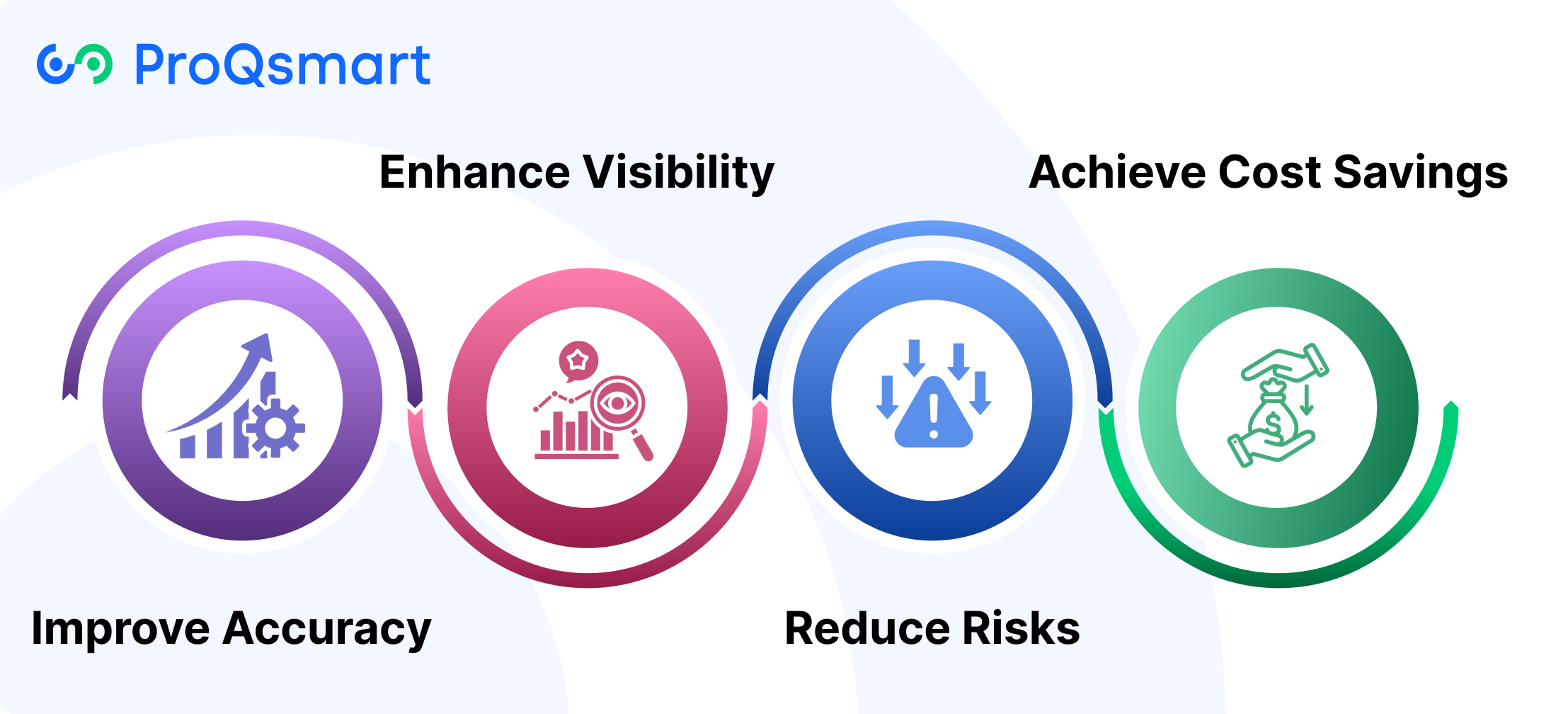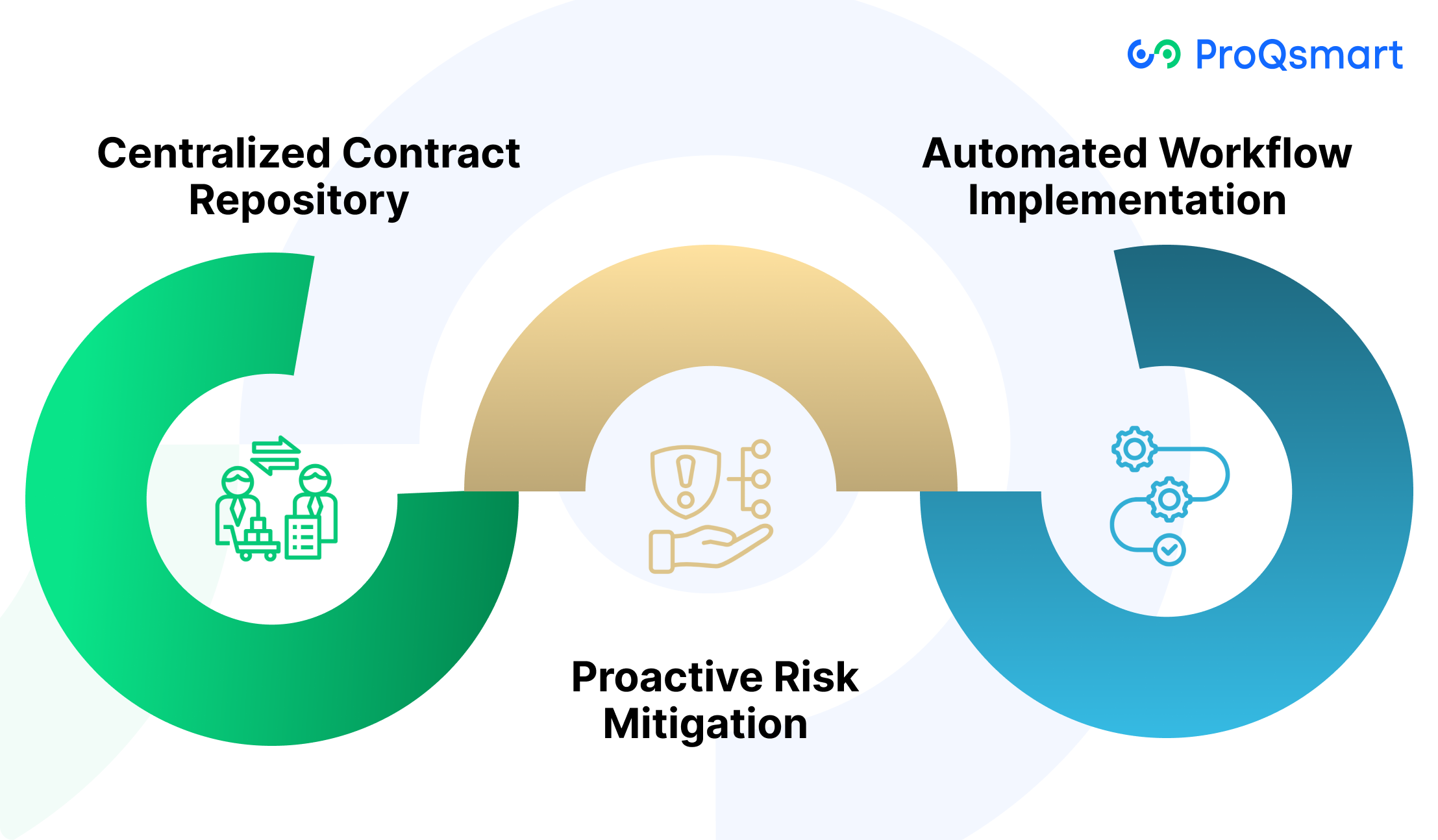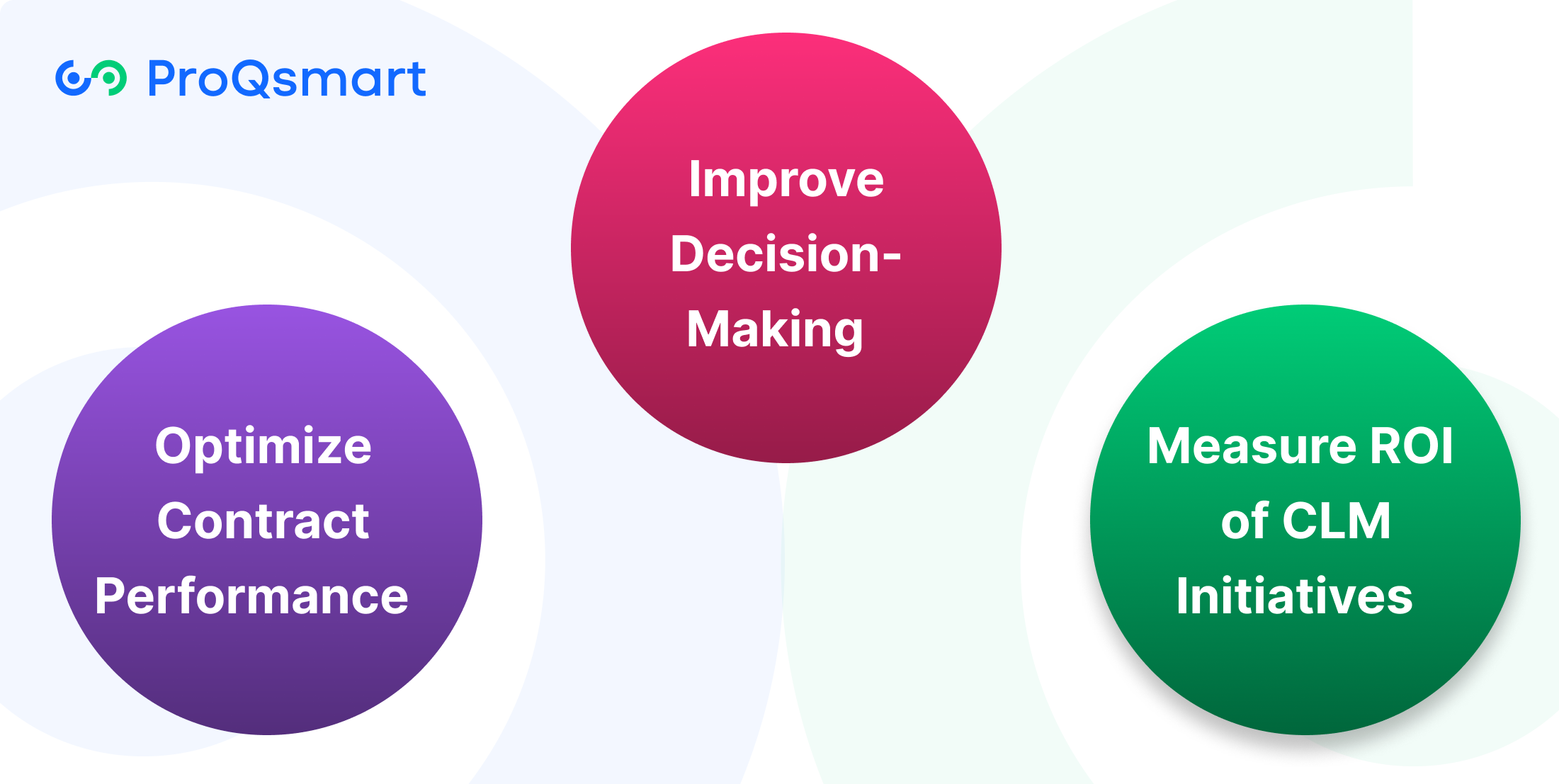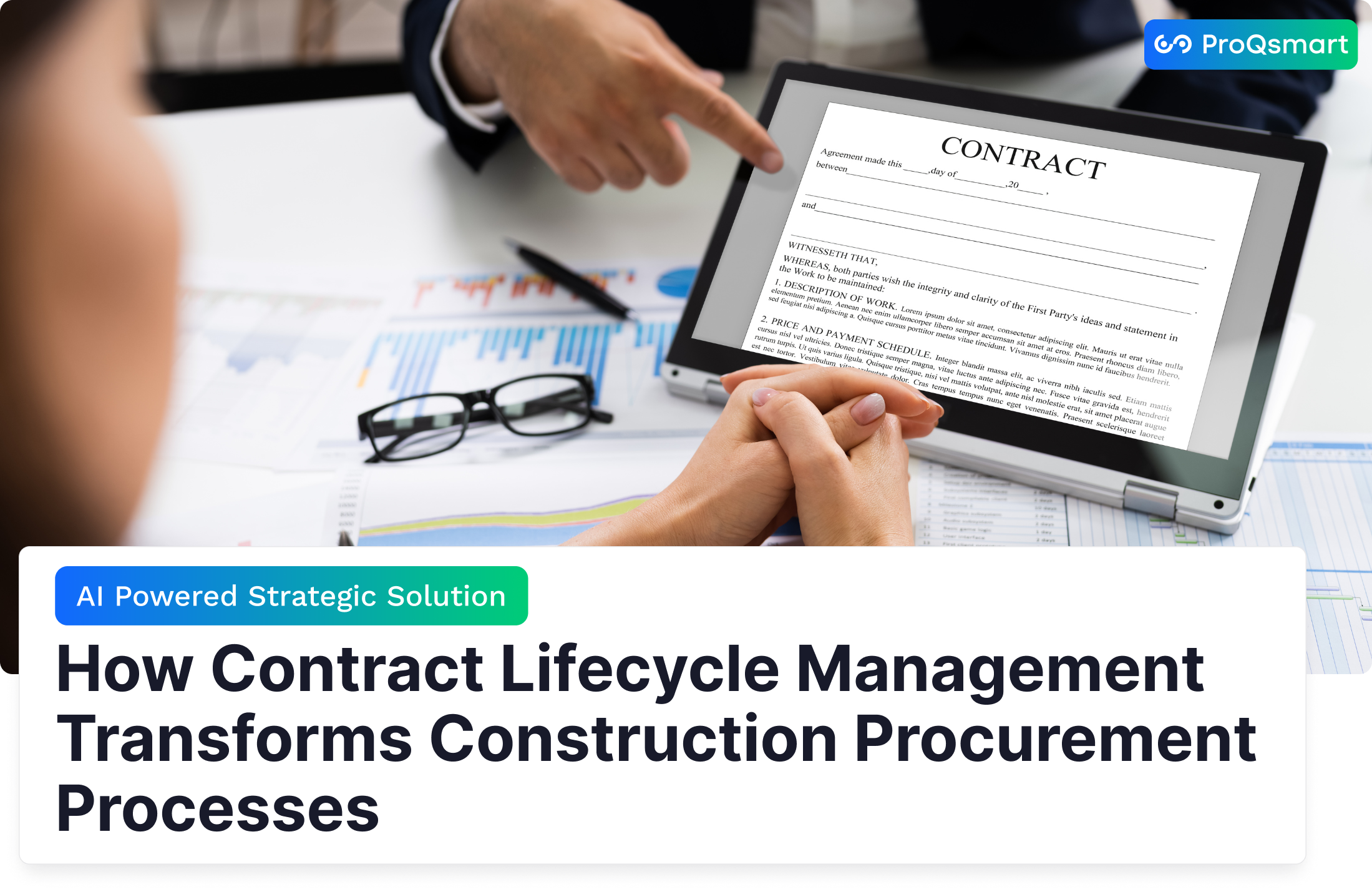Contract lifecycle management (CLM) is the more structured, strategic approach to managing contracts. It addresses the entire lifecycle, from initiation and execution through performance, renewal or expiration.
It provides transparency, compliance, and efficiency at every step of a contract’s lifecycle. With automated governance of workflows and consolidated contract data, CLM mitigates risks, fosters more productive supplier relationships, and facilitates more informed decision-making.
In procurement, optimizing CLM is essential to ensuring procurement operations are productive and in line with today’s stringent regulatory requirements. Utilizing advanced tools and technology as part of your CLM gives you real-time insights that empower your business to reduce time and maximize cost savings.
By learning the nuances of CLM, procurement professionals can save valuable time in their processes, accomplishing strategic objectives and facilitating lasting growth in their respective fields. The areas below dive deeper into the essential aspects and advantages of CLM.
What is Contract Lifecycle Management (CLM)?
CLM is a strategic approach to managing contracts through their lifecycle, from initial drafting through completion or renewal. It streamlines the process to make sure each stage is managed optimally, creating more value and less risk while ensuring compliance.
This approach is essential for organizations managing a diverse range of agreements across departments such as procurement, legal, and sales. By maximizing CLM capabilities, companies can gain greater visibility into contract performance and promote cross-functional collaboration among stakeholders.
Stages of Contract Lifecycle
The contract lifecycle comprises distinct stages, each critical to effective management:
- Define objectives, scope, and stakeholder roles. These activities often involve determining business needs, conducting market research and drafting preliminary terms.
- Create detailed contracts using tools like Microsoft Word. Keeping metadata and history makes auditing the development pipeline accurate and detailed.
- Collaborate with stakeholders to finalize terms. ProQsmart makes a real-time collaborative process easy and effective, keeping everyone on the same page.
- Obtain necessary authorizations, streamlining with automated workflows for efficiency.
- Finalize contracts and begin implementation, supported by tools like e-signature integrations.
- Track obligations, deadlines, and supplier performance. ProQsmart helps ensure compliance with auditable, verifiable data.
- Assess outcomes and maintain records for future use.
Engagement and collaboration are key at every step, fostering transparency and keeping the process aligned with broad organizational priorities.
Challenges in Manual Contract Handling
We all know that manual processes can be inefficient and cumbersome. Tracking deadlines manually is not only risky, leading to non-compliance and missed opportunities, but takes valuable time.
For example, just 1% of organizations reach a state of complete unified contract visibility. Powered by ProQsmart’s AI-driven platform, you’ll proactively minimize errors and unlock greater efficiency across workflows.
Automated notifications make it simple to stay on top of deadlines, and features such as budget-driven procurement keep you on track financially. In other words, moving from a manual CLM process to an automated one improves efficiency and automates regulatory compliance.
Key Benefits of CLM Solutions

Contract lifecycle management (CLM) solutions are revolutionizing how enterprises and government agencies get the most out of their contracts, producing tangible benefits in efficiency, compliance, and collaboration. By automating critical processes and offering real-time insights, CLM empowers businesses to maximize contract value while reducing risks and operational costs.
Let’s turn our attention to the most important benefits of CLM solutions.
Improve Accuracy
CLM solutions minimize mistakes during contract creation and signing process through the use of preset templates and automated data population. These tools help you maintain consistency in language and formatting, reducing any discrepancies that might leave room for a dispute.
Version control features ensure the integrity of contract documents. They do this, in part, by auditing all changes and keeping one single source of truth over the document’s lifecycle. More accurate contracts lead to better compliance.
Contracts that outline obvious obligations help assuage misunderstandings and build trust with the other party.
Enhance Visibility
Centralizing all contracts—including contracts that drive service delivery, renew automatically, or change hands—is a common feature of CLM solutions. Centralized dashboards give you the wide-angle lens on all activity to monitor milestones or obligations to ensure everyone stays on track.
For example, automated alerts assist teams in proactively managing deadlines so that nothing slips through the cracks. This level of transparency strengthens informed decision-making, boosts accountability, and allows procurement teams to renegotiate better terms at the points of renewal.
Reduce Risks
Proactive monitoring offered by CLM solutions mitigates contractual risks. Compliance tracking ensures adherence to legal standards, while automated alerts prevent missed deadlines.
Risk assessment tools further identify potential issues early, allowing businesses to address them before they escalate. By connecting contracts to billing and fulfillment, CLM minimizes financial risks and errors, ensuring accurate revenue forecasting.
Achieve Cost Savings
Future-ready CLM optimizes administrative cost savings via automation, alleviating organizational legal teams to focus on more strategic work. Well-defined, crystal-clear contracts lead to fewer conflicts down the line, reducing renegotiation costs.
Procurement solution ProQsmart combines budget-driven sourcing with supplier performance monitoring. This maximizes cost efficiency and ensures that your organization’s contract management strategy is aligned with organizational objectives.
How CLM Transforms Procurement Processes

contract lifecycle management (CLM) is a game-changer for procurement teams, bringing organization, accuracy, and speed to procurement processes. It eliminates repetitive manual tasks, centralizes contract data, and ensures seamless integration with existing systems like ERP and CRM platforms.
In turn, procurement teams have access to real-time visibility and actionable insights. This frees them up to negotiate better contract terms, shorten cycle times, and realize millions in cost savings. Considering 61% of professionals report that manual processes are a major workflow bottleneck, CLM offers a well-defined solution to operations’ workflow bottlenecks.
Centralized Contract Repository
Acentralized contract repository is the foundation of successful CLM. By organizing all contracts in one easy-to-access location, teams improve visibility, alignment, and collaboration across the board.
For example, procurement and legal departments can quickly access contract versions and amendments with the click of a mouse, ensuring important decisions are data-driven and compliant. This organized storage naturally improves audit readiness, as any document requested is at your fingertips in a secure format.
Tools such as ProQsmart further enhance this ability by automating the organization of documents and allowing background collaboration, leading to increased clarity of operations.
Proactive Risk Mitigation
CLM solutions take an active approach to looking for risks and resolving them before they turn into serious issues. With continuous monitoring, powered by next-generation data analytics, you can anticipate future problems and maintain compliance.
ProQsmart helps monitor compliance with contract requirements and key milestones. This is crucial for businesses to mitigate reputational risks related to supplier non-compliance, thereby protecting brand image and operational continuity.
Automated Workflow Implementation
Automation capabilities within CLM increase the speed of contract creation and approval processes, slashing cycle times and improving quality by reducing human error.
ProQsmart’s AI-driven workflows remove the need for repetitive manual processes, so things like approvals and follow-up reminders happen smoothly and automatically. This has greatly increased the speed, accuracy, and effectiveness of procurement.
Role of CLM in Construction Industry : Benefits
In construction, CLM increases the productivity of project management. It centralizes and automates workflows, making it easier to manage relationships with subcontractors and maintain compliance with safety and regulatory standards.
ProQsmart, for instance, monitors bills of quantities and pre-qualifies subcontractors, making sure things stay within budget and are properly monitored. By promoting standardized communication and documentation of task completion, CLM tools reduce risks associated with delays or conflicts.
These solutions reduce turnaround time and increase cost savings. They deepen relationships and trust and most importantly, greatly minimize litigation and conflict, establishing a pathway for operational success to take root.
What are the Essential Features of a CLM System?
A good Contract Lifecycle Management (CLM) system streamlines the entire contract workflow, providing standardization, visibility, and collaborative engagement all around. By offering features like centralized data storage, real-time notifications, version control, and seamless integration with existing tools, a robust CLM system enhances both operational efficiency and compliance.
Here, we dive into these features to explain how they can help you do more with less and take contract management to the next level.
Centralized Data Storage
Centralized data storage is central to efficient, effective contract management. It brings all contracts together into a centralized, secure repository, allowing for easy access and retrieval of essential information in seconds.
Having this structured approach makes it easier to track across the lifecycle, from initiation to renewal. For sensitive data, secure storage solutions employing encryption and cloud platforms, ensure protection against breaches while supporting compliance.
Further, centralized storage simplifies audits, making it easy to provide a clear, organized record of all contract activity.
Real-Time Notifications Setup
With deadlines and milestones around every corner, real-time notifications are an important feature of contract management software. Automated alert notifications let teams know what’s due so they never miss a deadline and can take action in advance of obligations.
ProQsmart’s enterprise-grade CLM solution automatically flags renewal reviews. It tracks who’s responsible for what, which improves accountability and encourages proactive management.
This ensures no responsibilities fall through the cracks, minimizing risk with responsibilities.
Version Control Importance
Version control protects your contract’s integrity ensuring that every revision is accounted for while allowing all stakeholders to operate under the latest document available. By automatically logging changes, it reduces human error and ensures total accountability.
ProQsmart’s built-in versioning ensures all users are working with the exact same language and terms. This capability enhances your compliance initiatives in an audit or disagreement.
Integration with Existing Tools
Customizable integration with current ecosystems CLM systems that integrate and build on existing platforms create efficiencies, better workflows, and improve data accuracy.
ProQsmart’s AI-driven tools, like our data extraction and risk analysis tools, for instance, allow for collaboration between stakeholders, leading to quality decision-making.
This integration ensures that CLM processes closely map to bigger business goals, providing significant, measurable value throughout procurement and sourcing activities.
Streamline Contract Management
Smart contract lifecycle management (CLM) best practices are essential to driving operational excellence and connecting procurement strategies to enterprise objectives. To simplify this process, institute strong, centralized systems that can adequately and efficiently manage and track the contracts.
Leverage relational databases to filter metadata easily and to keep all detailed historical data for context. An organized and thorough CLM process streamlines everyday workflows. Additionally, it increases visibility and improves cross-functional decision-making between legal, finance, and procurement.
Automate Contract Creation
Automation transforms contract drafting by standardizing the creation process. Implementing templates with predefined clauses provides greater consistency, saves time, and reduces the opportunity for human error through manual entry. Tools such as ProQsmart have AI-driven capabilities that streamline this process, allowing for quicker procurement cycles and increased accuracy in documents.
Streamlining contract creation through automation empowers teams to spend more time on critical strategic initiatives and less time on mundane admin tasks, boosting efficiency overall.
Simplify Approval Processes
CLM solutions make approvals painless with explicit workflows and automated routing. By establishing clear approval hierarchies, bottlenecks are immediately removed, allowing for speedy turnaround times and guaranteed compliance.
Automated notifications proactively notify all stakeholders of pending actions so there are no hold-ups and the process is always visible. ProQsmart’s workflow automation strengthens collaboration and ensures adherence to regulatory requirements, making it an ideal choice for businesses aiming to streamline approvals effectively.
Manage Renewals Efficiently
Managing renewals efficiently is the key to keeping vendor partnerships relevant and cutting costs. Consider renewal compliance CLM tools that help you keep track of renewal dates and obligations with automated reminders and alerts to avoid lapsing.
Proactive renewal management identifies and reduces risks while ensuring continuity of the contract. ProQsmart’s supplier performance monitoring capabilities take this a step further by providing regular evaluations of vendor compliance, helping you retain value over the entire life of the contract.
Leverage Data Analytics

Data analytics is key to the contract lifecycle management process (CLM). It delivers more timely and actionable insights that optimize contract performance, improve operational decision-making, and generate quantifiable business value. By leveraging advanced contract lifecycle management software, organizations can unlock opportunities to further improve process efficiency, reduce risks, and deliver strategic outcomes more accurately and efficiently.
Optimize Contract Performance
Data analytics identifies underperforming areas within contracts, enabling targeted improvements. Develop key performance indicators (KPIs) including contract cycle time, compliance rates, and supplier performance that will serve as measurable benchmarks to define success.
For example, monitoring missed deliverables or payment delays using AI-powered contract analysis software can surface trends in inefficiencies that warrant further investigation and action. Something advanced like natural language processing (NLP) pinpoint key milestones and requirements post-execution.
This will help to make sure you are staying out in front of deadlines and managing responsibilities. Optimization through data-driven adjustments aligns contracts with broader business objectives, such as cost reduction or supplier reliability, leading to enhanced outcomes.
Improve Decision-Making
Analytics gives decision-makers the information they need, when they need it, to take action quickly and avoid or mitigate disasters. As an example, termination date analysis allows sales teams to better time renewals and upselling opportunities.
Data visualization tools help clarify complex datasets, allowing for trends and performance metrics to be displayed in a way that is easily understood. This level of clarity allows for more strategic and data-driven planning, forecasting, and risk management.
With platforms like ProQsmart, which integrates AI-driven workflows and supplier monitoring, stakeholders can make informed decisions that align with organizational priorities.
Measure ROI of CLM Initiatives
Tracking cost savings, efficiency gains, and overall impact are all factors that go into logically determining ROI. Automating workflows eliminates the repetitive manual work, allowing your teams to focus their energy and time on more strategic initiatives.
Platforms like ProQsmart, which include tools like budget-driven procurement and Capital Expenditure sourcing, help private markets leading to a measurable ROI. These insights alone would make a compelling case of investments in CLM, but they further prove CLM’s value in creating productivity and compliance.
Conclusion
A well-implemented contract lifecycle management (CLM) system is more than just a tool—it becomes a strategic asset that empowers organizations to operate smarter, more efficiently, and with greater precision. By automating administrative tasks and providing access to real-time data, CLM systems enable informed decision-making, whether it’s maintaining compliance, creating cost efficiencies, or optimizing procurement workflows.
CLM solutions play a pivotal role in risk reduction by identifying potential issues early and enabling faster deal closures. Beyond streamlining contract management, they foster innovation, enhance collaboration, and support organizations in staying competitive in dynamic markets.
ProQsmart offers cutting-edge CLM solutions designed to transform contract management processes. With AI-driven analytics, automated workflows, and real-time dashboards. Explore ProQsmart’s contract lifecycle management solutions today—book a demo to experience smarter tools for better outcomes.




